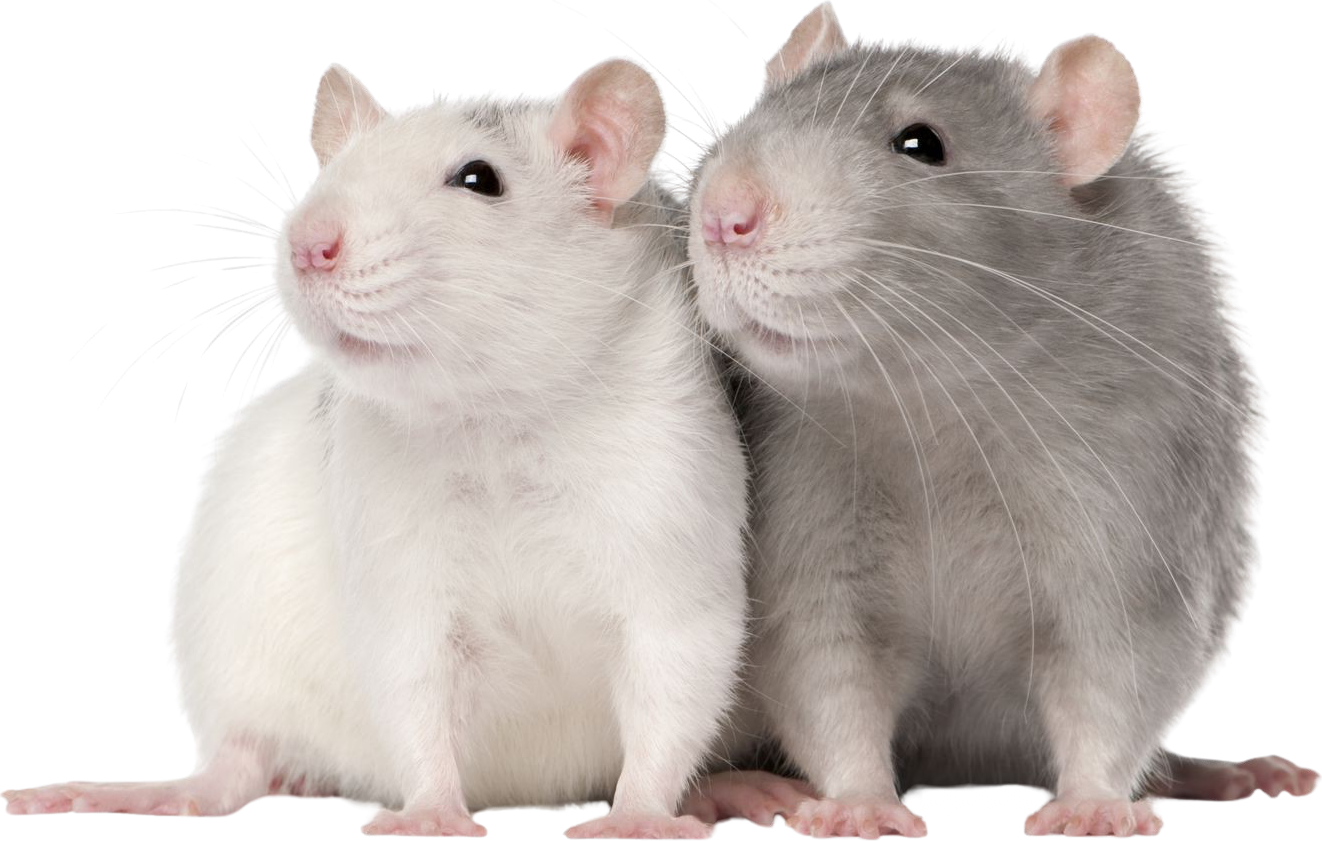LATEST UPDATE: July 2024
Research on animals costs many millions of lives (and billions of taxpayer dollars) each year. Millions more animals are bred and kept confined in laboratories and cages, awaiting their turn for experimentation. Biomedical research using animals is a largely secretive process and the public knows little about what goes on in research labs. This exclusive Faunalytics Fundamental examines the use of animals in research, exploring the scope and nature of the issue based on the best available data.
Meet The Animals
Animals commonly used in research live rich and complex lives. Primates exhibit deep thought and intricate social structures; their similarity to humans has made using them unthinkable for most purposes other than experimentation (and “entertainment”). Dogs like beagles are docile, friendly, and cooperative – traits that make them easier to manage as test subjects. Guinea pigs, who have become synonymous with animal research, are gentle and even purr like cats when they’re happy. Mice and rats are empathetic and studies have shown that they will risk themselves to rescue cage-mates in captivity. There is no doubt that the animals we use for research and dissection are capable of thinking, feeling, and suffering just like we are. Below we explore facts about some of the animals most commonly used in research. Of course, we’re only scratching the surface of what makes these animals sentient, unique, and deserving of their own rights to life and freedom.

Rats & Mice
are compassionate and intelligent animals who are used extensively.
- Sentient & Smart – They remember sources of pain and have a long-lasting aversion to them
- Cage Boredom – They can quickly become bored unless provided with enrichment
- Have A Heart – They have gregarious personalities and live in cohesive social groups

Guinea Pigs
are sweet and sensitive creatures with nuanced social needs.
- Active Animals – They love to play and need “boredom breakers” to stay stimulated
- Happy Pop – They are known to jump in the air — called “popcorning” — when excited
- A Balancing Act – They have complex and delicately balanced social structures

Dogs
are used in research because they are gentle, obedient, and curious.
- Mother’s Intinct – They are highly protective of their own puppies and even human babies
- Strength In Numbers – They have a deep pack instinct and struggle with separation anxiety
- Led By The Nose – They have an extraordinary sense of smell and a strong urge to investigate scents

Primates
are our closest animal relatives, and struggle deeply in captivity.
- Healing Touch – They groom each other after conflicts to repair damaged relationships
- Getting Their Point Across – They communicate through vocalizations, facial expressions, and gestures
- Cool Tools – They use a variety of objects as tools to help solve problems
Attitudes
Opinions about the use of animals for research are complicated and often divided when it comes to different purposes or types of research. For instance, a clear majority of people in the United States are against the use of animals for testing cosmetics and personal care products. However, if the research is claimed to save or improve human lives, opinions shift, even if those claims are hypothetical. In the data below, we explore public opinion on various animal issues.
In the above, we can see that support for animal research in general seems to be dwindling, and uncertainty is rising even when no alternatives exist. We can also see that the perception of research is highly contingent on the species being used; it is similarly contingent on the reason for the research, with biomedical research leading in acceptability — though still barely above 50% — and cosmetics at the low end. In a good sign for animal advocates, 30% of respondents feel that animal research is unacceptable for any of the reasons listed.
Breeding And Transport
Before they arrive at laboratories, animals used for research are born, bred, and housed in large breeding facilities found throughout the world. Some research animals may come from relatively regulated companies such as Charles River or Inotivco, based in countries like the United States, England, or Spain. Other animals such as monkeys often come from international suppliers that operate, often illicity, in Southeast Asia, parts of Africa, and China. Below, we connect some of the dots of the global breeding and transport of research animals, with Southeast Asia as an example.
In The Laboratory
How many animals are bred for research, kept in laboratories, and used in experiments? Under current regulations in virtually any country around the world, it’s impossible to arrive at an exact figure. The number is hotly contested and debated among those on either side of the debate, and no one knows the total with certainty; the issue hinges on the fact that some lab animals are counted, while most are not.
Estimates for the total number of animals used in research worldwide range widely, from over 100 million to over 190 million, while estimates for the U.S. range from 12-24 million. In the U.S., researchers are not required to report the numbers of rats, mice, and birds used in experiments, and these species combined make up an estimated 93-97% of all animals used in research. Below, using statistics and insights from pro-animal testing organizations themselves, we look at the stark difference in welfare coverage, as well as a percentage breakdown of animals covered by the AWA.
The Animal Welfare Act is inadequate and ignores the big picture — not only does the act not cover most animals, it does not mandate that researchers maintain any statistics for the species used most frequently. Therefore, we can only make educated estimates on the numbers of animals being used.
Meanwhile, research facilities, already kept hidden from public view, have very few official controls or oversight for most of the work they do. For animal advocates, it is important to spotlight these facilities and the often egregious suffering that they house.
The above map shows animal experimentation labs and breeding facilities in the U.S. You can look up the animal research facilities in your state using this tool from the USDA, the agency in charge of animal laboratory inspections. Simply enter a year, and the state, and the tool will list the facilities.
The prevalence of such operations throughout the country may be surprising to find. Unlike farms and feedlots that we often see while driving through the countryside, animal research and breeding facilities are often in urban centers, yet much more hidden from view. Likewise, the laws that govern and regulate experimentation in the U.S. (and many other places in the world) do their part to obscure both the scope and the nature of animal research taking place.
In the Classroom
Conventional wisdom says that the best way for students to learn about biology is through hands-on learning, usually involving the dissection of dead animals. Dissection, in various forms, has been used as a learning tool for centuries, and it’s estimated that 10-12 million animals are used each year — though that is a very loose estimate and no official statistics are kept.
Thankfully, scientific advancements and public opinion are starting to help turn the tide. A study by Faunalytics on behalf of the National Anti-Vivisection Society found that only half of students are interested in dissecting animals and more than a third (37%) of students would prefer to use alternatives to animal dissection. What’s more, a study by the American Anti-Vivisection Society found that 75% of U.S. adults agree that “students taking biology courses should be allowed to choose alternative methods of learning that do not involve dissecting animals.”
Support for dissection isn’t just dwindling. Students are actively demanding alternatives to the use of animals in grade school classrooms. In response, many schools have created what are called “student choice policies,” which allow students to opt-out of dissection for ethical reasons. Unfortunately, such policies are not ubiquitous yet; in the U.S., only 21 states and the District of Columbia allow students to choose alternatives. Even when such policies exist, teachers and students may not be aware of them. The Faunalytics/NAVS study mentioned earlier showed that only 53% of educators in states with student choice policies knew about those policies. The same study found that 38% of students didn’t know if alternatives were available to them. Thanks to the work of anti-vivisection groups, this is changing.
Alternatives
If you aren’t swayed by the ethical arguments against animal research, perhaps this will change your mind: approximately 100 vaccines have shown effectiveness against HIV-like animal viruses, but none prevent HIV in humans. More than 1,000 potential have been tested in animals, not one was found to benefit humans with stroke, but none has been found to benefit humans with stroke. While the biomedical research industry is quick to claim victories, the reality is less glamourous: nine out of ten drugs fail in clinical studies because they cannot predict how they will behave in people; only 8% of drugs tested on animals are deemed fit for human use; one meta-study found that animal trials overestimate the likelihood that a treatment works by 30% because negative results often go unpublished. Fortunately, using animals in scientific research is not a foregone conclusion. On the contrary, there is a burgeoning field of alternatives to animal research, and many such alternatives are already in use today.
The above graphic shows a small selection of some of the most exciting and promising alternatives to animal research that exist today. There are many others that are available, and even more are on the way. Among the many organizations and institutions working on better alternatives are FRAME, INTERNICHE, and Animalearn who are leading the way in promoting clinical and educational alternatives.
This Faunalytics Fundamental has provided a visual overview of the use of animals in research. The result is a complex picture: public opinion is mixed and context-specific; the number of animals used is a guesstimate due to lack of reporting for the most commonly used species; and laws are not keeping pace with students’ interest in dissection alternatives. The scientific establishment has a lot of inertia in favor of continuing the use of animals in research, but is slowly shifting towards alternatives.
Meanwhile, millions of animals are trapped in labs, waiting for us to help them. The data presented here raise many questions for how to invest limited advocacy resources:
- How can advocates galvanize the majority of the public that believes research animal welfare is important and guide them towards supporting elimination and alternatives? Looking a public opinion research such as this and this can help advocates to target different public audiences on a case by case basis.
- What can animal advocates and members of the public do to contribute to the development of research alternatives? Education about alternatives and their effectiveness is key.
- Public opinion for various animal research issues is somewhat contradictory and confused. What are the most effective ways that advocates can clarify the issues? First, animal advocates needs to educate themselves on the science, and then communicate that effectively.
- As animal research regulations become more stringent in some parts of the world, “outsourcing” to laboratories in other parts of the world may become a bigger issue. How can advocates anticipate and prevent this trend?
These are questions advocates should think about and possibly research further.
For more information about animals used in research, and to find out more about research animal advocacy, we encourage you to check out the Physician’s Committee For Responsible Medicine, the National Anti-Vivisection Society, Cruelty Free International (formerly the British Union for the Abolition of Vivisection, founded in 1898), the White Coat Waste Project, among others. For more study summaries and Faunalytics resources related to animal research, check out our Library wing on the topic.
There is so much more work to be done to give advocates the insight they need to choose the most effective ways to help animals. Please donate generously now to help us bring you and other advocates this crucial information.
This project was supported by the Regina Bauer Frankenberg Foundation.



